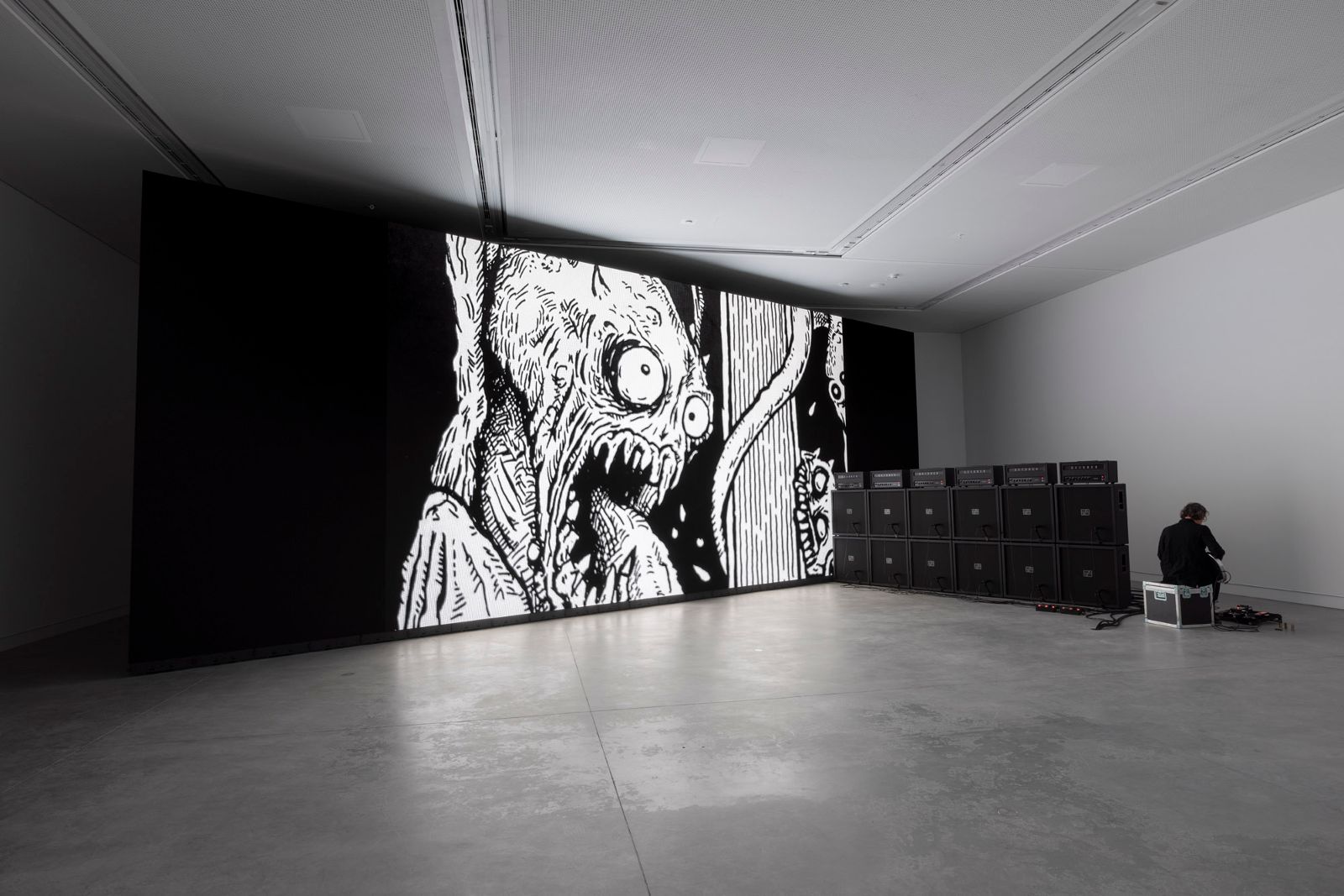
Can we perceive an image without knowing it? Do we need to know what we are looking at to either believe or to perceive the thing being observed? How do we know what we know? In his polemical book La Société du Spectacle (1967), French Marxist theorist and philosopher Guy Debord wrote: ‘when the real world is transformed into mere images, mere images become real beings—dynamic figments that provide direct motivations for a hypnotic behaviour.’[1] In turn, these images or representations of society become an instrument for social control as well as a ‘a separate pseudo-world…where even the deceivers are deceived.’ So, how do we wake up from this deceptive hallucination?
Anchoring his spectator inside this hallucinogenic spectacle—inside the image, inside the noise and inside the artifice, experimental noise musician and multidisciplinary artist Marco Fusinato’s radical live noise-guitar performance and installation DESASTRES provokes similar questions. Seen as the organising principle for this show, Fusinato’s intention appears as much about revealing how this hallucinatory spectacle functions, as (paradoxically) creating a momentary negation, an interruption and a revolt against it.
Curated by Alexie Glass-Kantor for the Australian Pavilion in The Milk of Dreams, the 59th Venice Biennale, DESASTRES embodies a dynamic exchange between sonic and optical vibrations amplifying at epic velocities–noise, rapidity, discursivity, concord, simultaneity and disjuncture. ‘Using the electric guitar as a tool for mass amplification is a kind of energy transfer for Fusinato,’ says Glass-Kantor. ‘From his perspective as a musician, mastery of an interface between electronics and instruments—and specifically, in this case, the system for DESASTRES—becomes a form of embodied knowledge for the artist. 200 days. Every day. Take a breath and check the pace-maker.’[2]
The installation consists of two minimal sculptural elements: a free-standing multipaneled LED screen at cinematic scale—projecting black and white images of decay, collapse and death, reaching a rate of sixty images per second: decapitated heads, explosives, disaster, war, volcanic eruption, civil protests, anarchist graffiti, riots, moon, sun, fourteenth century frescoes, wood cuts: possibly works from Hans Holbein’s Dance of Death series, alongside an amplification wall made up of 100-watt full stacks, and the artist–Fusinato, with his back to his spectators playing an electric guitar connected to a custom-built control unit with effects pedals regulating the tempo.
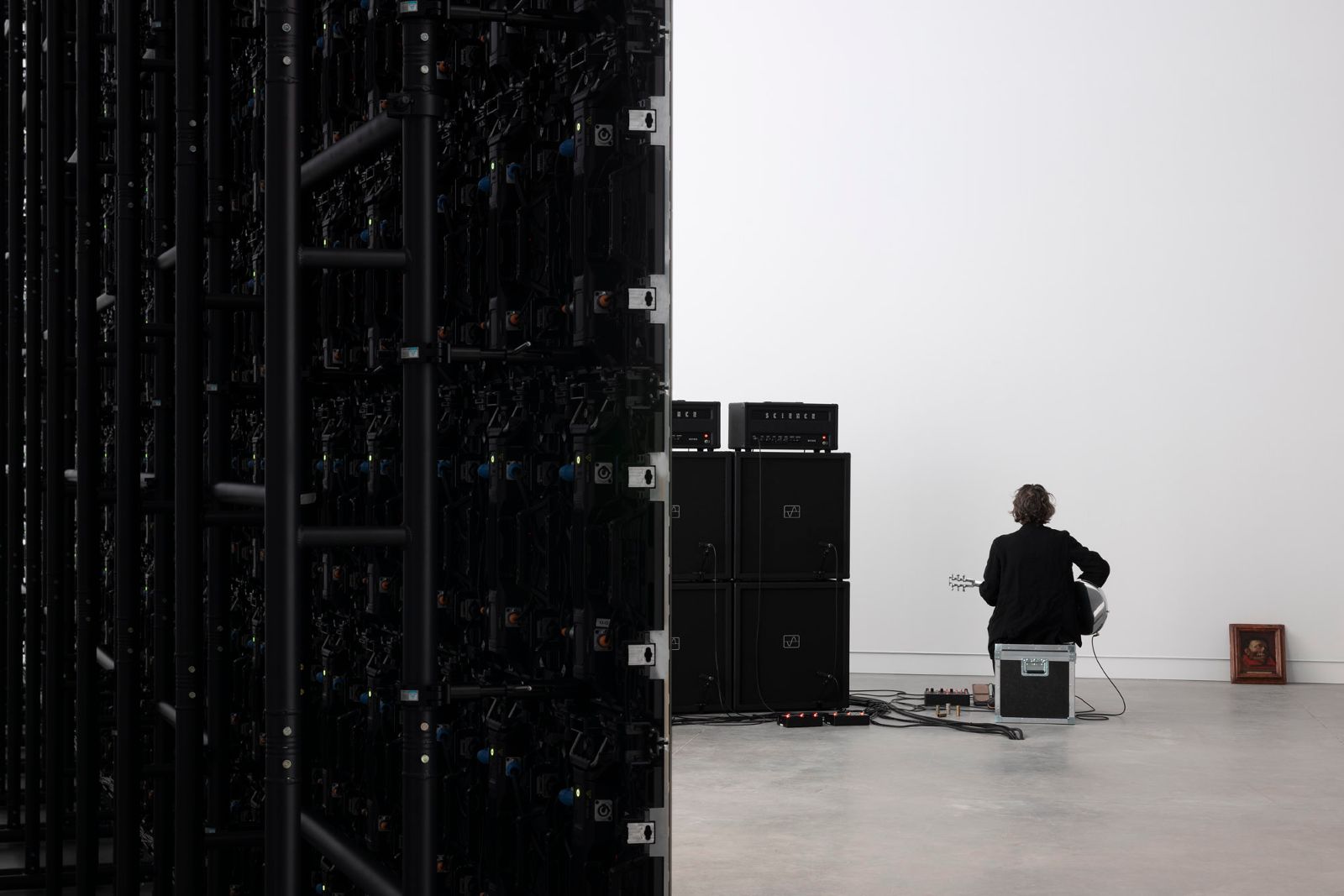
The frequency in the room is transfixing—antithetical, allegorical, resistant, underground and jarring. And the vibration obscured—where the only light source emerges from the poetics of destruction—scintillating fractalizing images pulsating on screen. Generating ‘noise as sculpture’ every fragment that makes up each image and every particle that sounds in this work transforms into sonorous sculptural matter. ‘The mass indexing is a mess—a morass of disparate and disconnected randomly generated images,’ says Fusinato. ‘The intent is to create some kind of hallucination, elation from disorientation and exhaustion from confusion.’
Stimulating another kind of exhaustion, Fusinato challenges his own mental and physical endurance by employing the Australian pavilion as a type of laboratory or de-facto studio to perform for 200 days throughout the duration of the biennale. Reminiscent of his earlier work Spectral Arrows (2012-present) first performed at the Glasgow International Arts Festival in 2012, an all-day long-durational improvisation where Fusinato, using guitar and electronics, performs mechanically as a worker, again, with his back to his audience. Critically evaluating the political undercurrents associated with notions of labour and work, in Spectral Arrows the artist took a radically different approach to defy traditional expectations, and to also interrupt the anticipation of a spectacle while challenging the role of the spectator.
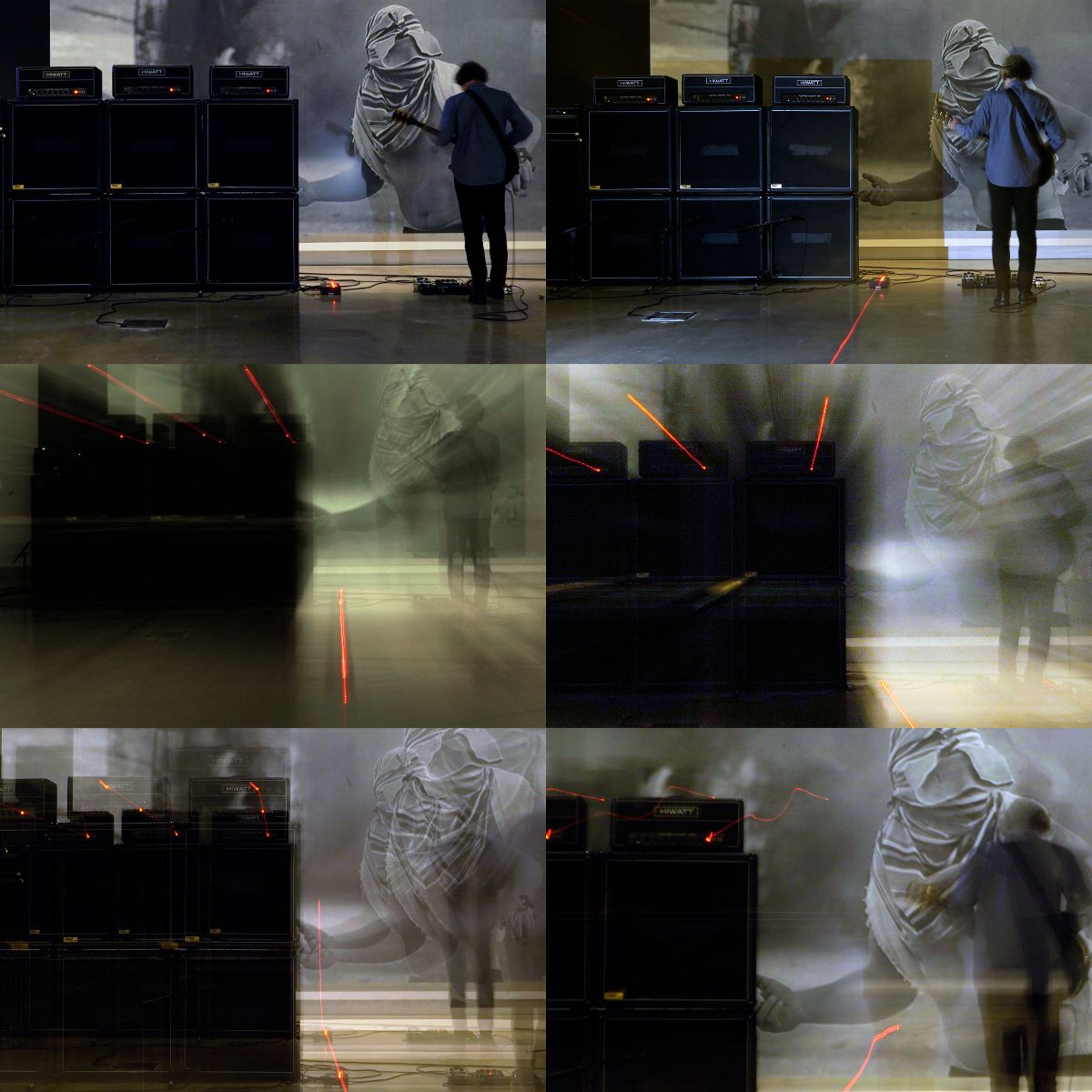
Fusinato’s antithetical provocation and politically charged gestures are often driven by his pursuit to ‘unfuck the world.’[3] Growing up in the suburbs of Melbourne in the ‘70s, as an Australian/Italian with parents from the Veneto region, and a cultural language emerging from the anti-fascist divide during the Second World War, alongside the radical currents of the post-war Italian Communist Party, Fusinato turned to subcultures such as anarcho-punk—The Clash, Sex Pistols, CRASS—and death-metal to find a discourse independent to the mainstream, inviting new political questions about the cultivation of dominant systems of knowledge, culture and of capitalist ideologies.
An avid collector of anarchist pamphlets, the artist’s radical treatment and intelligent examination into the semiotics of sound and its relationship to the history of images and material culture—capitalism, epistemology, labour, embodied perception—also reveals something else. The artist extends the representation of noise as art into a new conceptual contextualisation. ‘My approach to the guitar is conceptual as opposed to technical,’ Fusinato says. ‘I remember as a kid going into guitar shops and seeing titles in the book section like “how to play in the style of…” I learnt early on that, no matter how much I tried, I could never do that. I didn’t have the ear, the patience, or the technical ability to play like anyone from those books. I realised that there’s no section in the shop for “How NOT to play in the style of…” and that it’s possible to develop your own language by understanding and embracing your limitations.’[4]
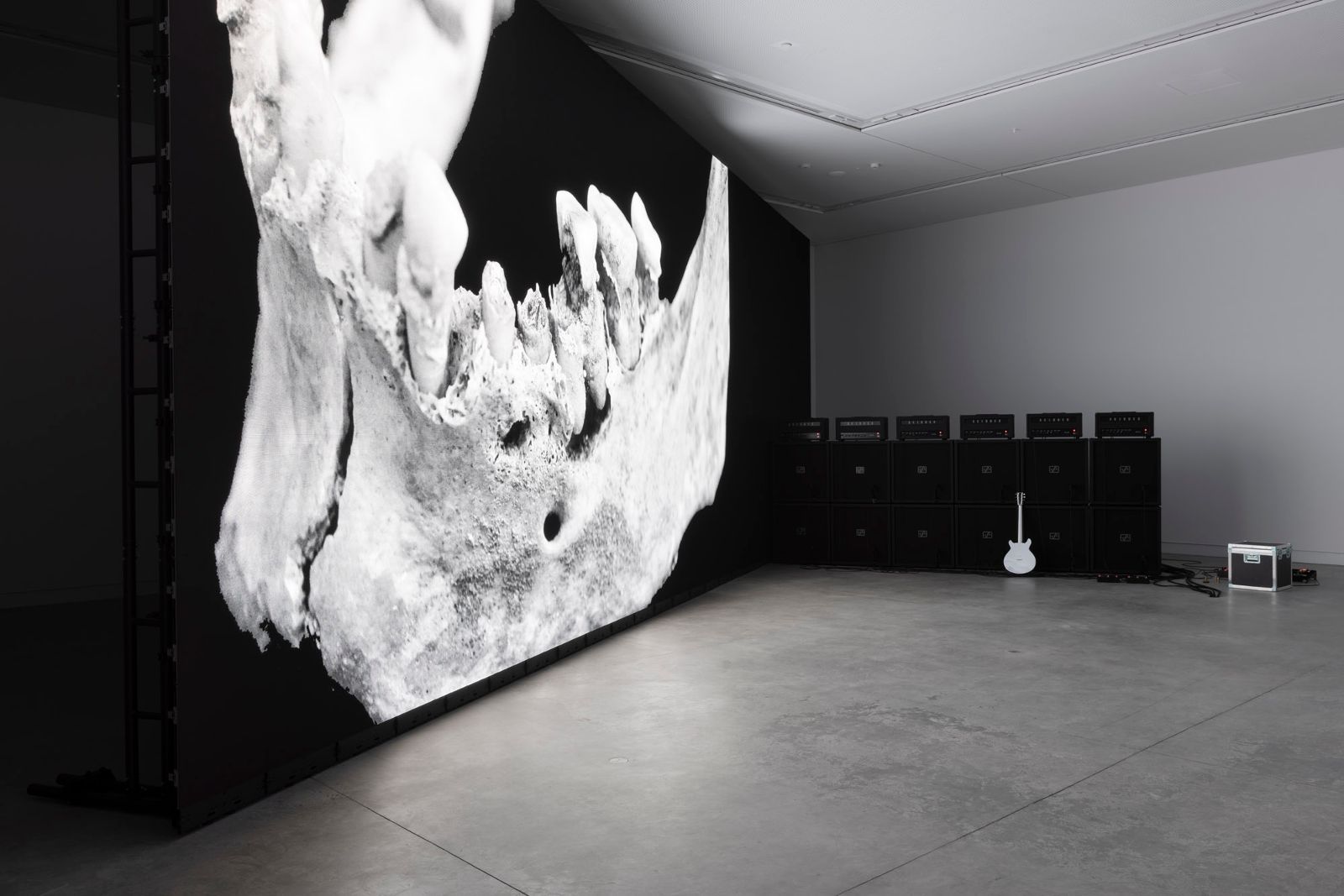
What initially appeared as a limitation for Fusinato, subsequently invited new possibilities within his practice, as well as the broader discourse of noise, performance and sound art. More specifically, the artist’s treatment of music, as a conceptual process rather than technical, allowed him to develop a new language, such as releasing his ‘sound’ from the confinements of Western guidelines. Traditionally, such constraints governed the way in which sound, music or noise was composed and categorised to be considered authentic within that tradition.
Central to this idea of releasing or liberating sound from its historical contextualization, and negating conformist accounts of representation, in DESASTRES, Fusinato achieves a similar outcome with his appropriation of images, where he releases the historical context or source through a process of abstraction. In his essay on Fusinato, The Rhythm of Disintegration, art historian Branden W. Joseph notes how the manipulation of these images, through cropping, decontextualisation, context-shifting and enlargement, emancipates them from representation. He discusses American art historian Douglas Crimp’s examination of the Pictures Generation, drawing parallels with Fusinato’s practice: ‘…[his] pictorial appropriations accomplish much the same outcome, freeing representation, in Crimp’s terms, “from the tyranny of the represented.’”[5] While the emphasis here is about questioning the agency and construction of representation, and the governing power of images, it also points to Fusinato’s parallels with the Pictures Generation, who were also influenced by Conceptual and Pop art and notions of authorship.
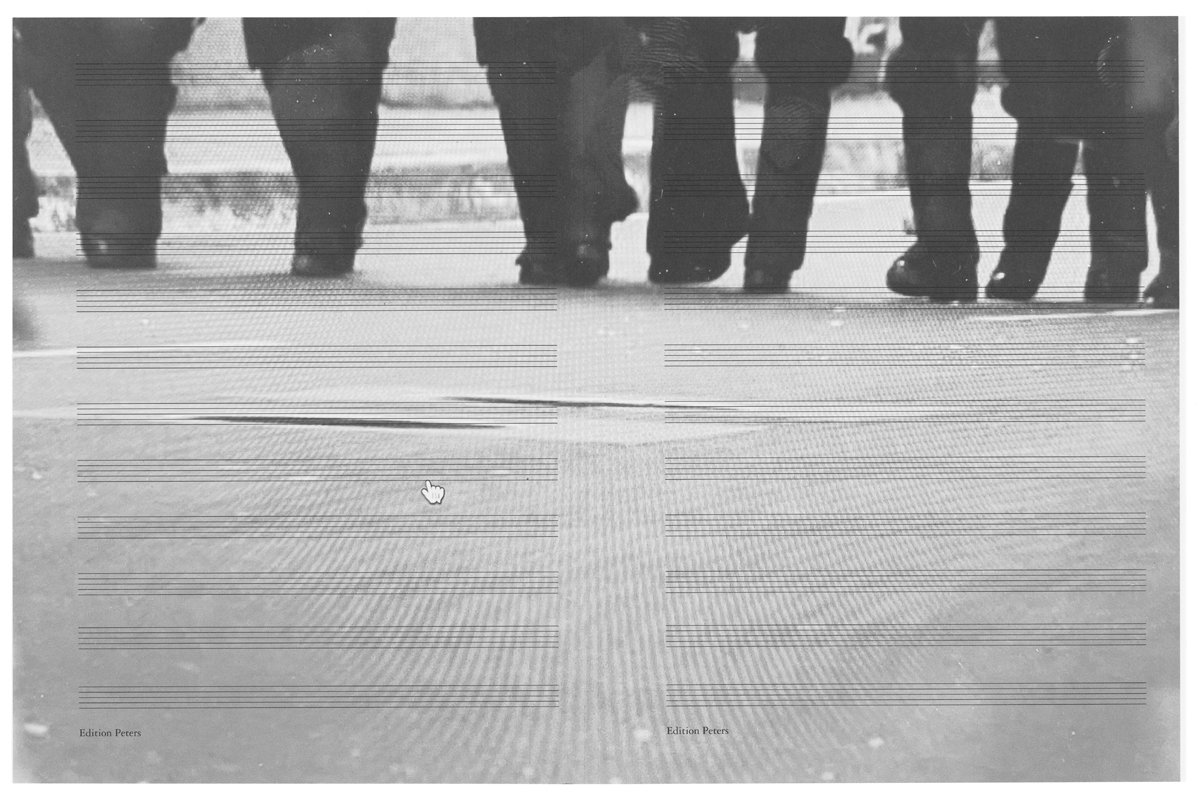
Fusinato’s process of physically sourcing and archiving a cacophony of existing images from multiple translations of the word DESASTRES (death and disaster, a nod to Goya’s Los Desastres de la Guerra, The Disasters of War), on the internet and then obscuring and fragmenting each image to an indiscernible state, polarises his desire to interrupt the spectators’ habitual process of recollection and associative recognition. The mode of recollection is dependent on memory, intention and signification, so when this process is interrupted each image becomes observed from a completely new vantage point and indexicality. This yields a disorientation between what we think we know, and what we actually perceive, in these images. In other words, Fusinato’s objective may be to trigger the activity of recognition while simultaneously negating it.
As a result, with no point of reference nor the ability to recognise the thing or object being observed, the spectator becomes immobilised and disorientated within the space, affecting not only the way we process time but also our spatial awareness. Furthermore, the resulting effects from this momentary dislocation and interruption, activate a shift in vision where the avalanche of images become conceptually rendered as pure motion or essence, and appear as a sequence of movements pulsating at rapid speeds analogous to transmitting light or data. ‘The crux of the work resides in the immaterial, the illumination from the images on the screen and the physicality of the sound from the amplification,’ says Fusinato. ‘The intent is to make something sculptural, filling the gallery not with bronze or marble but with radiant light and vibrations filling the air.’ Within this metaphysical encounter, DESASTRES creates an interplay between vibration, light and information, creating an enigmatic eruption—a deeply physical tension between disembodiment and embodiment, between ‘silence’ and ‘noise.’
Interested in such dichotomies, Fusinato’s practice is often about cultivating an intermediate space between ‘order and disorder, the institution versus the underground, noise versus silence and purity versus contamination.’ Similarly, in this work, Fusinato integrates diverging intensities from the political tonalities and satirical content often found in punk or doom death-metal sounds with the repetitive successive harmonies—spatial, serial and infinite—evocative of minimalist compositions. While minimalist composers such as La Monte Young and John Cage sought reduction in sound, in an attempt to also sculpt the immaterial and induce a type of transcendent reawakening, by contrast Fusinato’s radical, discordant, and at times, deafening sound, likewise achieves a comparable transformative experience.
Inside La Monte Young and Marian Zazeela’s immersive sound and light installation Dream House (1969–) for example, the combination of Zazeela’s light mobiles alongside La Monte Young’s continuous sine wave frequencies, create an environment where the saturated visual and sonic fields produce a similar experience to the ganzfeld effect, with no point of origin, where the body becomes de-stabilized while inducing new kind of optical and perceptual ambiguity. Comparatively, Fusinato’s oversaturation of visual stimuli and aggressive sounds, each without referential basis, produce a similar over-sensationalised stimulation where the body either retreats or becomes completely entrenched in the mediation. What is found in this state of elevation, is nothingness, pure essence, where the ‘audible becomes inaudible.’
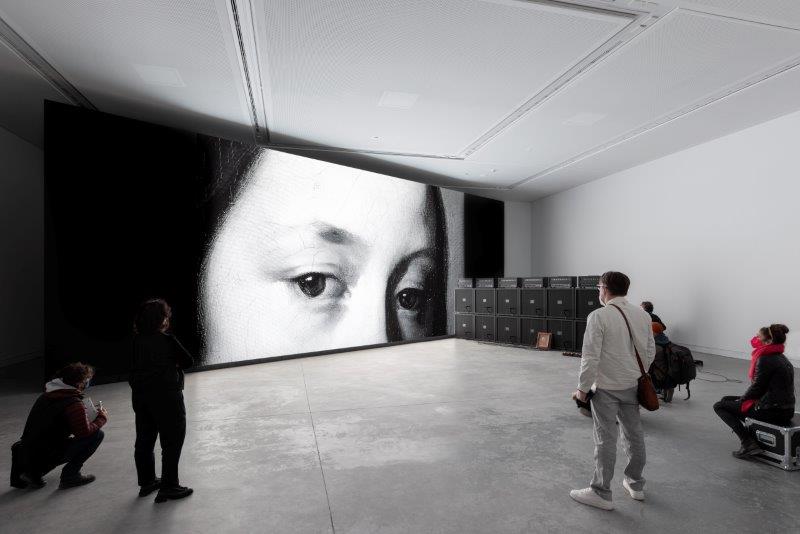
On the one hand, DESASTRES is a political revolt and a radical protest. And on the other, a metaphysical encounter—activating an experience beyond the limits of the perceptible. The optical and sonic systems at play conceivably bring us closer to understanding the mechanism that conditions a particular way of seeing and of obtaining knowledge. Fusinato’s DESASTRES provides much more than a synchronicity of sound and image. It is an existential act, leading us into the ruptures of both amplification and sublimity, a space in between, where death and disaster become symbols for something else, beyond vision and sound altogether. The artists’ memento- mori of a decapitated head decomposing on a book, created by a follower of the seventeenth century Italian Jacopo Ligozzi, becomes an emblem, a mysterious mascot providing clues to the artist’s message. Perhaps, the end is the beginning for Fusinato, where we start from a place of un-contamination, a tabula rasa returning to pure frequency and vibration.
Footnotes
- ^ Guy Debord, Society of the Spectacle (London: Rebel Press, 2005), 11
- ^ See Alexie Glass-Kantor, World Without End, in DESASTRES accompanying exhibition publication first published in Venice in April 2022, Australia Council for the Arts and Lenz on the occasion of the exhibition pp. 254
- ^ See Audio Arts magazine supplement 1983, cassette tape of Joseph Beuys interview from Marco Fusinato http://marcofusinato.com/wordpress/wp-content/uploads/FRIEZE_QUESTIONNAIRE1.pdf
- ^ See interview with Alexie Glass-Kantor and Marco Fusinato in DESASTRES
- ^ See Branden W. Joseph, The Rhythm of Disintegration, in DESASTRES
